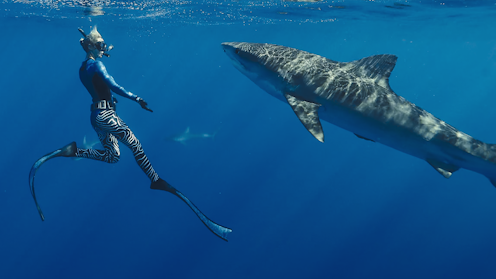The new Netflix documentary, Shark Whisperer, presents a transformative view of the great white shark, portraying it not as a relentless predator but as a misunderstood creature deserving of protection. At the forefront of this initiative is Ocean Ramsey, a model and marine conservationist, who narrates her personal journey intertwined with the mission to improve the public’s perception of sharks.
While the documentary aims to promote shark conservation, critics argue that it leans heavily on the allure of Ramsey’s appearance to capture attention. Ramsey acknowledges this approach, stating, “People look first and listen second. I’ll use my appearance, I’ll put myself out there for a cause.” Her husband, photographer Juan Oliphant, supports this sentiment by claiming that her beauty aids their cause, making her an effective advocate for sharks.
Exploring Cultural Narratives
The imagery associated with sharks has long been shaped by popular culture, particularly since the release of Jaws in 1975. This film established a narrative that continues to influence contemporary portrayals of sharks as fearsome creatures. Ramsey and her team tap into this legacy, attempting to shift the narrative while still engaging with the established tropes of fear and fascination.
Ramsey’s media presence often features her swimming alongside sharks, which draws parallels to previous films like Deep Blue Sea and The Shallows, where female characters are frequently depicted in revealing attire. Such portrayals prompt discussions about the intersection of environmental advocacy and sexualized imagery. Critics label this phenomenon as “sexy conservationism,” raising questions about the effectiveness and ethics of using physical appearance as a platform for serious causes.
Despite these criticisms, Ramsey and Oliphant are dedicated to changing the narrative surrounding great whites. Their work includes not just awareness campaigns but also practical applications, such as shark-diving tours and merchandise sales, with proceeds supporting conservation efforts. While Ramsey engages with smaller tiger sharks in many filmed segments, the documentary emphasizes her dramatic encounters with larger great whites, suggesting a calculated approach to draw in viewers.
Balancing Activism with Reality
The film’s narrative also parallels themes of personal growth often found in shark-related media. Ramsey’s journey reflects a broader trend of using shark encounters as metaphors for overcoming personal struggles. Similar themes resonate in recent films like The Reef: Stalked, where protagonists confront past traumas through their interactions with sharks.
Despite the upbeat portrayal in Shark Whisperer, the stark reality remains that over 80 million sharks are killed annually worldwide, a fact that the documentary does not shy away from presenting. While Ramsey’s efforts have contributed to significant policy changes, such as Hawaii becoming the first U.S. state to ban shark fishing, the duality of her approach—bridging conservation with commercial appeal—remains a point of contention.
In conclusion, while Ocean Ramsey may argue that her methods are justified by their outcomes, the debate around the effectiveness of visually appealing conservation efforts continues. As the documentary wraps up with a montage of joyful moments shared with sharks, it serves as a reminder of the ongoing struggle to preserve these creatures in the face of overwhelming threats. The juxtaposition of beauty and activism raises pertinent questions about the future of conservation in the digital age, where image often speaks louder than action.





























































